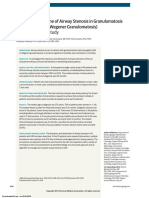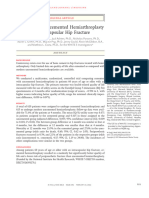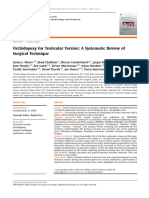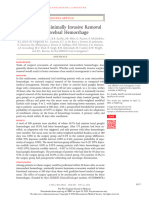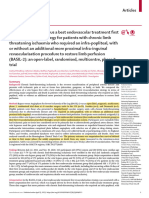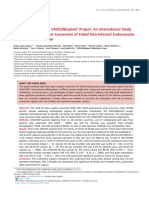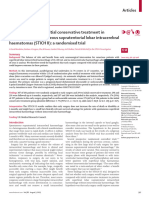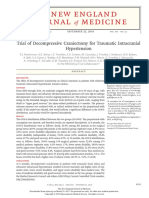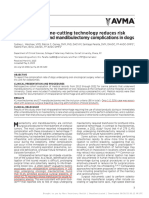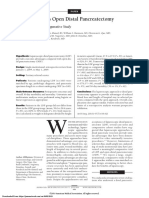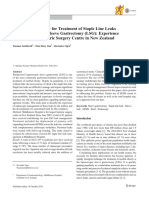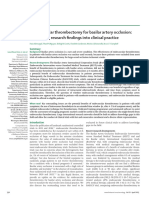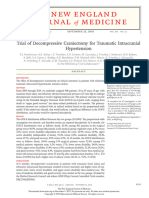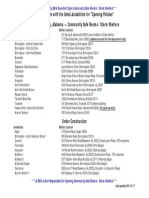1 s2.0 S0140673616318037 Main
1 s2.0 S0140673616318037 Main
Uploaded by
Andre RamaCopyright:
Available Formats
1 s2.0 S0140673616318037 Main
1 s2.0 S0140673616318037 Main
Uploaded by
Andre RamaOriginal Title
Copyright
Available Formats
Share this document
Did you find this document useful?
Is this content inappropriate?
Copyright:
Available Formats
1 s2.0 S0140673616318037 Main
1 s2.0 S0140673616318037 Main
Uploaded by
Andre RamaCopyright:
Available Formats
Articles
Comparison of stapled haemorrhoidopexy with traditional
excisional surgery for haemorrhoidal disease (eTHoS):
a pragmatic, multicentre, randomised controlled trial
Angus J M Watson, Jemma Hudson, Jessica Wood, Mary Kilonzo, Steven R Brown, Alison McDonald, John Norrie, Hanne Bruhn, Jonathan A Cook,
on behalf of the eTHoS study group*
Summary
Background Two commonly performed surgical interventions are available for severe (grade II–IV) haemorrhoids; Lancet 2016; 388: 2375–85
traditional excisional surgery and stapled haemorrhoidopexy. Uncertainty exists as to which is most effective. The Published Online
eTHoS trial was designed to establish the clinical effectiveness and cost-effectiveness of stapled haemorrhoidopexy October 7, 2016
http://dx.doi.org/10.1016/
compared with traditional excisional surgery.
S0140-6736(16)31803-7
This online publication has been
Methods The eTHoS trial was a large, open-label, multicentre, parallel-group, pragmatic randomised controlled trial corrected. The corrected version
done in adult participants (aged 18 years or older) referred to hospital for surgical treatment for grade II–IV first appeared at thelancet.com
haemorrhoids. Participants were randomly assigned (1:1) to receive either traditional excisional surgery or stapled on October 26, 2016
haemorrhoidopexy. Randomisation was minimised according to baseline EuroQol 5 dimensions 3 level See Comment page 2328
score (EQ-5D-3L), haemorrhoid grade, sex, and centre with an automated system to stapled haemorrhoidopexy or *Members listed at end of paper
traditional excisional surgery. The primary outcome was area under the quality of life curve (AUC) measured with the Raigmore Hospital, Inverness,
EQ-5D-3L descriptive system over 24 months, assessed according to the randomised groups. The primary outcome Scotland, UK
(Prof A J M Watson FRCS); Centre
measure was analysed using linear regression with adjustment for the minimisation variables. This trial is registered
for Healthcare Randomised
with the ISRCTN registry, number ISRCTN80061723. Trials (J Hudson MSc,
J Wood BSc, A McDonald MSc,
Findings Between Jan 13, 2011, and Aug 1, 2014, 777 patients were randomised (389 to receive stapled haemorrhoidopexy Prof J Norrie MSc) and Health
Economics Research Unit
and 388 to receive traditional excisional surgery). Stapled haemorrhoidopexy was less painful than traditional
(M Kilonzo MSc, H Bruhn PhD),
excisional surgery in the short term and surgical complication rates were similar between groups. The University of Aberdeen,
EQ-5D-3L AUC score was higher in the traditional excisional surgery group than the stapled haemorrhoidopexy Aberdeen, UK; Sheffield
group over 24 months; mean difference –0·073 (95% CI –0·140 to –0·006; p=0·0342). EQ-5D-3L was higher for Teaching Hospitals, Sheffield,
UK (S R Brown MD); and Centre
stapled haemorrhoidopexy in the first 6 weeks after surgery, the traditional excisional surgery group had significantly for Statistics in Medicine,
better quality of life scores than the stapled haemorrhoidopexy group. 24 (7%) of 338 participants who received University of Oxford, Oxford,
stapled haemorrhoidopexy and 33 (9%) of 352 participants who received traditional excisional surgery had serious UK (J A Cook PhD)
adverse events. Correspondence to:
Prof Angus J M Watson,
Department of Surgery,
Interpretation As part of a tailored management plan for haemorrhoids, traditional excisional surgery should be
Raigmore Hospital,
considered over stapled haemorrhoidopexy as the surgical treatment of choice. Inverness IV2 3UJ, Scotland, UK
angus.watson@nhs.net
Funding National Institute for Health Research Health Technology Assessment programme.
Copyright © The Author(s). Published by Elsevier Ltd. This is an Open Access article under the CC BY license.
Introduction principally involves rubber band ligation for lower grade
Haemorrhoids are swellings of the sub mucosal veins at haemorrhoids, whereas surgical interventions are used
the top of the anal canal. Symptoms from haemorrhoids for higher grade haemorrhoids where banding has been
include bleeding, pain, prolapse and peri-anal itch with unsuccessful. Rubber band ligation is a clinic-based
prevalence rates of up to 44% within the general procedure where a small band is placed at the top of a
population.1,2 A substantial proportion of the population haemorrhoid to reduce its size by interfering with tissue
will have symptoms of haemorrhoids within their blood supply. The widely adopted Goligher system3 for
lifetime and the presence of per-rectal bleeding, and its grading haemorrhoids was used in this trial.
association with colorectal cancer, can cause anxiety.2 Given the prevalence of the condition, the
The initial management of haemorrhoids is community management of haemorrhoidal disease continues to
based, where no concern exists about the presence of have considerable workload and costs implications for
colorectal cancer or inflammatory bowel disease. Dietary the National Health Service (NHS), with approximately
manipulation, bulk forming laxatives, and advice should 25 000 haemorrhoidal procedures being performed as
be offered first. Persistent symptoms merit referral for hospital day-case or inpatient admissions in England in
investigation and treatment. Outpatient treatment 2006–07.4 Over the past two decades, understanding of
www.thelancet.com Vol 388 November 12, 2016 2375
Articles
Research in context
Evidence before this study –0·140 to –0·006]; p=0·0342). Participants in the traditional
A Health Technology Assessment evidence synthesis and excisional surgery group had fewer symptoms at 12 and
six systematic reviews published between 2006 and 2015 have 24 months (both p<0·0001) and reported fewer recurrences at
assessed the role of stapled haemorrhoidopexy versus traditional 12 (39/278) and 24 months (76/300) compared with the
excisional surgery. Over 50 randomised controlled trials have stapled haemorrhoidopexy group (94/295 at 12 months and
been conducted of variable size and quality. These studies have 134/317 at 24 months). Rates of continence and tenesmus
suggested short-term pain was higher with traditional excisional were better in the traditional excisional surgery group than in
surgery than stapled haemorrhoidopexy though recurrence was the stapled haemorrhoidopexy group; complications were
also higher with stapled haemorrhoidopexy. Previous economic similar in both groups. Pain and analgesic use were lower in the
assessments of these operations were based on limited quality stapled haemorrhoidopexy group in the first 3 weeks after
of life data, and suggested a shorter operation time for stapled surgery, but time to return to normal activity 6 weeks after
haemorrhoidopexy than traditional excisional surgery. There was surgery was similar between groups. No difference was
also a paucity of medium-to-long-term clinical and economic observed in length of stay or operating time between
data regarding stapled haemorrhoidopexy or traditional groups. Traditional excisional surgery was found to be more
excisional surgery particularly for grade II haemorrhoids. cost-effective than stapled haemorrhoidopexy terms of
cost-effectiveness.
Added value of this study
We did a large multicentre, open-label, randomised controlled Implications of all the available evidence
trial of 777 patients comparing stapled haemorrhoidopexy The results of this study show that although both stapled
with traditional excisional surgery. To our knowledge, this is haemorrhoidopexy and traditional excisional surgery are
the largest trial of this treatment comparison for equally safe, traditional excisional surgery has better quality of
haemorrhoids. The overall quality of life was significantly life and is associated with fewer symptoms and recurrence of
better for the traditional excisional group than the stapled haemorrhoids. Additionally, stapled haemorrhoidopexy is more
haemorrhoidopexy group over 24 months (–0·073 [95% CI expensive and is not cost-effective.
the anatomy of haemorrhoids has improved, leading to and more advanced disease eligible for eTHoS. The
the introduction of new surgical technologies into authors of HubBLe concluded that if rubber band
clinical practice, often without previous robust ligature was considered as a course of treatment,
assessment. These technologies included stapled recurrence rates of haemorrhoids were similar to that
haemorrhoidopexy and haemorrhoidal artery ligation, with haemorrhoidal artery ligation, and haemorrhoidal
variants of which are promoted through surgical artery ligation was more expensive and not
technology industries. The purported advantages of the cost-effective.14 The aim of the eTHoS trial was to assess
new treatments, when compared with an existing whether stapled haemorrhoidopexy was more effective
surgical technique, traditional excisional surgery (or and cost-effective compared with traditional excisional
haemorrhoidectomy), were less postoperative pain with surgery in the treatment of grade II, III, and IV
similar symptom control.5 haemorrhoids. The primary objective was to compare
Despite numerous small-scale randomised controlled health-related quality of life derived over 24 months.
trials, significant doubts remain about the usefulness,
efficiency, and cost-effectiveness of stapled haem- Methods
orrhoidopexy and haemorrhoidal artery ligation.6 Study design and participants
Evidence synthesised in systematic reviews and Health The eTHoS trial was a large, open-label, multicentre,
Technology Assessments7–13 has highlighted the lack of parallel-group, pragmatic randomised controlled trial
good quality data on which to base management done in 32 UK NHS hospitals. Potential participants were
choices. This led to the National Institute of Health adults aged 18 years or older referred to hospital for
Research commissioning two trials to perform robust surgical treatment for haemorrhoids. Patients with
assessments of the newer techniques (eTHoS and haemorrhoids (grade II–IV), who provided written
haemorrhoidal artery ligation vs rubber band ligature informed consent, were eligible to take part. Participants
for the management of symptomatic grade II and III referred to hospital with haemorrhoids were included in
haemorrhoids [HubBLe]). The HubBLe trial recently the trial if their symptoms were refractory to rubber band
reported its results which compared haemorrhoidal ligature or haemorrhoidal artery ligation or if their
artery ligation with rubber band ligature. Although a haemorrhoids were thought to be too large for these
small overlap exists between HubBLe and eTHoS, the treatments to be successful. Those precluded from the
trials were designed to dovetail together with less trial included patients who had previous surgery for
advanced disease falling mainly into the HubBLe trial haemorrhoids (traditional or stapled) and those who had
2376 www.thelancet.com Vol 388 November 12, 2016
Articles
previous surgical treatment for anal sphincter injury maintaining the haemorrhoids in their new position.
repair, or had symptomatic incontinence or peri-anal Stapled haemorrhoidopexy is done with the use of a
sepsis. Those with known inflammatory bowel disease or stapling gun. Three haemorrhoid stapling devices are
malignant gastrointestinal disease, within the past 5 years, commonly in use within the UK (Johnson & Johnson,
or who were deemed medically unfit for surgery, were also Chex, and Covidien). Reflecting the pragmatic nature of
ineligible, as were pregnant women. The exclusion criteria the trial, surgeons were able to use the gun which they
were set to have a minimum effect on the overall numbers normally use in their routine practice.
of participants recruited to the trial and hence maximise There are two commonly used traditional excisional
generalisability. The study was approved by the North of procedures done across the world: open19 and closed.20
Scotland Research Ethics Committee on June 18, 2010 Both have the intention of excising the haemorrhoidal
(reference number 10/20802/17). The protocol was cushions. The procedure is most commonly done with
published in 2014.15 electrocautery. In this trial, surgeons undertook whichever
procedure they would do as part of their routine practice.
Randomisation and masking The use of the Ligasure Medtronic (Minneapolis, MN,
Participants were randomly assigned (1:1) to receive USA) and Harmonic Ethicon Johnson and Johnson (NJ,
either traditional excisional surgery or stapled USA) devices to perform an excisional haemorrhoidectomy
haemorrhoidopexy with the use of an automated system were excluded in this trial. On the day of surgery, the grade
with telephone and web-based interfaces run from the of surgeon and anaesthetist and the type of anaesthesia
trial office. The randomisation minimisation algorithm and the surgical technique were recorded. Additionally, the
used included centre, grade of haemorrhoidal disease length of time the procedure took and any intraoperative
(II, III, or IV), baseline EuroQol 5 dimensions 3 level complications were recorded. Data for postoperative
(EQ-5D-3L) descriptive system score,16 and sex. Patients complications before discharge, which included post-
and investigators were not masked to treatment operative bleeding, pelvic sepsis, the need for blood
allocation. transfusion, and urinary retention were collected.
Participants were followed up for 24 months; this
Procedures consisted of a single clinic visit followed by multiple
Participants were recruited by surgeons and research postal questionnaires completed by the participant.
nurses in the outpatient department. The surgeons and Routine data were also used to measure recurrence and
research nurses were also responsible for initiating further treatment. At the 6 week clinic appointment, data
randomisation. Eligible and consented participants were for postoperative complications including haemorrhage,
placed on the appropriate waiting list by the treating requirement for blood transfusion, anal stenosis,
colorectal surgeon or a designated team member. anal fissure, urinary retention (which required
The EQ-5D-3L UK wording and population norms catheterisation), residual anal skin tags, difficult
(range –0·59 to 1·0, with 1·0 being optimum),16 36-item defecation, wound discharge, pelvic sepsis, and pruritus
Short Form Health Survey (SF-36) version 2 score, were collected. Clinical examination of the anal canal was
Cleveland incontinence score (CIS; range 0–20, with not routinely performed. Further haemorrhoid-related
0 being optimum), and Haemorrhoid symptom score interventions since discharge and the need for further
(HSS; 0–26 range, with 0 being optimum) were collected planned medical and/or surgical treatments for
pre-randomisation as baseline measures.17,18 Other data haemorrhoids or complications associated with treat-
collected at baseline included height, weight, grade of ment were recorded. Postoperative examination of the
haemorrhoid, anticoagulant medication prescriptions, anal canal during the 6 week follow-up clinic was
and previous treatments for haemorrhoids. Each centre’s included in the protocol but was not done routinely if
participating surgeons had received appropriate patients reported that their symptoms were improving.
recognised training for both stapled and traditional This is in line with current practice and was also adhered
haemorrhoid surgery and were using the procedures to in the HubBLe trial.
routinely in their hospitals. Surgery was only done by EQ-5D-3L and visual analogue scale (VAS) pain data
surgeons in the late stage of training if they had been were collected by postal questionnaire at 1 and 3 weeks
signed off by their supervising consultant surgeon, or if after surgery. EQ-5D-3L, SF-36, HSS, CIS, and VAS data
they were operating under the direct supervision of their were collected by postal questionnaire at 6 weeks
consultant. Preoperative and postoperative care followed after surgery. Additionally, questionnaires distributed at
the respective surgeon’s and NHS hospital’s standard 12 and 24 months after randomisation also collected data
policies. Stapled haemorrhoidopexy aims to correct for patient-reported haemorrhoid recurrence and further
haemorrhoidal prolapse by excising a ring of tissue above operations. Participants who did not respond to 12 and
the haemorrhoidal cushions with immediate re- 24 month questionnaires were sent a postal reminder
anastomosis of the mucosa with the use of staples. and a shortened version of the questionnaire containing
A secondary effect might be to reduce blood flow and the EQ-5D-3L only. The main outcome assessment was
therefore congestion. Fibrosis develops at the staple line planned at 24 months (from the date of randomisation)
www.thelancet.com Vol 388 November 12, 2016 2377
Articles
follow-up. Consent was sought from all participants to be
1127 patients screened flagged for notification of haemorrhoidal recurrence. To
71 ineligible
assess long-term safety, the participants were investigated
for further haemorrhoidal surgery through Hospital
1056 eligible patients Episode Statistics (HES) in England, Patient Database
279 excluded
225 declined Wales (PEDW) in Wales, and Information Services
33 clinical reasons Division (ISD) data in Scotland, when all participants
21 missed
777 patients randomly assigned had reached 12 months post-randomisation.
Outcomes
The primary outcome was the area under the quality of
389 assigned to stapled 388 assigned to traditional life curve (AUC) over 24 months derived from
haemorrhoidopexy excisional surgery
EQ-5D-3L measurements taken from patient question-
naires distributed at baseline, 1 week, 3 weeks, 6 weeks
1 post-randomisation 2 post-randomisation (postoperative), 12 months, and 24 months post-
exclusion exclusions
randomisation. The AUC is expressed in years and can be
interpreted as quality-adjusted life-years (QALYs). The
388 had clinical assessment 386 had clinical assessment primary trial economic outcome was incremental costs per
at baseline at baseline QALY gained with QALYs based on the responses to the
388 responded to questionnaire 386 responded to questionnaire
at baseline EQ-5D-3L over 24 months. Patient-reported secondary
outcomes were generic health profile measured by SF-36
and EQ-5D-3L, VAS pain score, CIS, HSS, postoperative
8 withdrew before surgery 7 withdrew before surgery
1 died before surgery 0 died before surgery analgesia consumption, recurrence of haemorrhoids, and
21 did not receive surgery 16 did not receive surgery tenesmus. Tenesmus can be a disabling symptom which is
described as a feeling of wanting to pass stool, even though
358 had surgery 363 had surgery
the rectum is empty. The clinical secondary outcomes were
301 had stapled 323 had traditional further interventions, intraoperative and postoperative
haemorrhoidopexy excisional surgery complications including haemorrhage, requirement for
37 had traditional 29 had stapled
excisional surgery haemorrhoidopexy blood transfusion, anal stenosis, anal fissure, urinary
18 had other surgical 11 had other surgical retention (which required catheterisation), residual anal
technique technique
2 unknown
skin tags, difficult defecation, wound discharge, pelvic
sepsis, and pruritus. A serious adverse event was defined
as an event occurring to a research participant that was
Follow-up 1 week after surgery Follow-up 1 week after surgery
301 completed questionnaire 296 completed questionnaire
treatment related (resulted from administration of any of
0 withdrew 3 withdrew the research procedures) and was expected or unexpected
that caused death, was life threatening, required hospital
admission, resulted in significant incapacity or disability,
Follow-up 3 weeks after surgery Follow-up 3 weeks after surgery
291 completed questionnaire 282 completed questionnaire or was otherwise considered medically significant by the
1 withdrew 3 withdrew investigators. Death, related or not to the study treatment,
was also recorded.
Follow-up 6 weeks after surgery Follow-up 6 weeks after surgery
347 had clinical assessment 357 had clinical assessment Statistical analysis
309 completed questionnaire 305 completed questionnaire
2 withdrew 5 withdrew
A sample size of 338 per group was required to provide
90% power to detect a difference in the mean area under
the quality of life AUC curve of 0·25 SDs derived from
Follow-up 12 months after Follow-up 12 months after EQ-5D-3L score measurements, with a significance
randomisation randomisation
295 completed questionnaire 278 completed questionnaire level of 5% (two-sided α). Data for the EQ-5D-3L AUC,
11 withdrew 14 withdrew in this patient group, were limited at the time of study
2 died 0 died
conduct but an SD of 0·25 was thought to be sufficient
to detect a worthwhile difference in quality of life
Follow-up 24 months after Follow-up 24 months after measures. To allow for 15% non-response in the
randomisation randomisation
288 completed questionnaire 274 completed questionnaire outcome, we randomly assigned 400 patients in each of
15 withdrew 16 withdrew the two groups. Such a sample size would also provide
2 died 0 died
Figure 1: Trial profile
295 included in primary analysis 275 included in primary analysis Numbers of participants declining further follow-up or not responding to the
questionnaire are cumulative in direction of participant flow.
2378 www.thelancet.com Vol 388 November 12, 2016
Articles
90% power to assess differences in the secondary
Stapled Traditional excisional
outcome of recurrence between the two surgical haemorrhoidopexy surgery (n=386)
techniques from around 10% to around 4%. This (n=388)
magnitude of difference was supported by a systematic Baseline characteristics
review,9 which showed a higher recurrence in the Age (years) 50 (40–60) 49 (40–59)
stapled haemorrhoidopexy group compared with the Sex
traditional excisional surgery group, but this was not Male 201 (52%) 197 (51%)
statistically significant. No adjustment in sample size Female 187 (48%) 189 (49%)
was made for the potential gain in precision due Body-mass index 27·0 (5·2); 372 27·0 (4·9); 367
to adjustment for the baseline EQ-5D-3L score,
Grade of haemorrhoid
haemorrhoid grade, or sex.
II 86 (22%) 86 (22%)
Study analyses followed a comprehensive, prespecified
III 243 (63%) 240 (62%)
statistical analysis plan. The main statistical analyses
IV 59 (15%) 60 (16%)
were based on all participants as randomised, irrespective
Previous haemorrhoid 139 (36%) 116 (30%)
of subsequent compliance with treatment allocation. treatment*
Prespecified subgroup analyses investigated the Pain (visual analogue 2·8 (2·7); 379 2·5 (2·6); 383
influence of haemorrhoidal grade and sex with the use of score)†
treatment by subgroup interaction effects. The primary EQ-5D-3L‡ 0·764 (0·264); 388 0·762 (0·246); 386
outcome measure was analysed with linear regression Cleveland incontinence 4·3 (3·9); 376 4·1 (4·0); 376
adjusting for the other minimisation variables as fixed score
effects with the exception of centre, which was accounted Haemorrhoid symptom 10·8 (4·7); 370 10·4 (4·7); 370
for using cluster robust standard errors. The preplanned score
principal analysis included participants with at least one Operative details
short-term post-surgery follow-up (1, 3, or 6 weeks) and Duration of operation (h) 0·4 (0·2); 346 0·4 (0·2); 359
at least one long-term measurement (12, 18, or Length of hospital stay 0·4 (0·3); 356 0·4 (0·4); 363
(days)
24 months), to calculate the AUC. Sensitivity analyses
Day cases 305/356 (86%) 317/363 (87%)
included all participants with a long-term measure.
Time to surgery (days) 68·2 (78·3); 358 68·8 (81·1); 363
Secondary analyses of the primary outcomes explored
sensitivity to assumptions regarding interpolation, Data are median (IQR), n (%), or mean (SD); N. EQ-5D-3L=EuroQol 5 dimensions
missing data (using multiple imputation by chained 3 level. *Previous haemorrhoid treatment refers to rubber band ligature or
haemorrhoidal artery ligation. †Scale range is from 0 (no pain) to 10 (worst
equations using the “ice” Stata command21 to impute the
imaginable pain). ‡The EQ-5D-3L index ranges from –0·59 to 1·0, with positive values
missing EQ-5D-3L scores 30 times before calculating the indicating a perfect outcome and negative values imply states worse than death.
AUC and then using Rubin’s rule to combine and
Table 1: Baseline characteristics and operative details
estimate), and also compliance (using a per-protocol
population consisting of those who received the allocated
intervention). The EQ-5D-3L AUC over 6 weeks and recommendations. As patients were followed up for
12 months was also compared. The secondary outcome more than a year, costs and QALYs were discounted at
tenesmus was analysed with the χ² test for trend, further the recommended rate of 3·5%.23 The economic data
surgical intervention was analysed with the χ² test. The analysis accounted for missing data using multiple
other secondary outcomes were analysed with generalised imputation. Both the statistical and the economic
linear models (ie, logistic regression) or linear mixed analyses were done using Stata, version 14. This trial
models with adjustment for the minimisation variables. is registered with the ISRCTN registry, number
Continuous variables were summarised with mean (SD) ISRCTN80061723.
or median (IQR) whereas discrete variables were reported
as absolute number and percentage in each category. All Role of the funding source
analyses were assessed at the two-sided 5% significance The funder of the study had no role in study design, data
level except for the subgroups which were assessed at collection, data analysis, data interpretation, or writing of
two-sided 1% level. the report. The corresponding author had full access to
A cost-effectiveness analysis in terms of incremental all the data in the study and had final responsibility for
cost per QALYs gained was undertaken. The costs of the the decision to submit for publication.
interventions were estimated by identifying, measuring,
and valuing resource use. Resource use was identified Results
and measured from case report forms and patient- Between Jan 13, 2011, and Aug 1, 2014, 1127 patients were
reported questionnaires and was valued with published screened for eligibility. Of these, 777 were randomly
source such as NHS reference costs.22 All costs were assigned to either receive stapled haemorrhoidopexy
estimated from the NHS and personal social perspective (n=389) or traditional excisional surgery (n=388;
as per National Institute for Health and Care Excellence figure 1). 774 participants were included in the analysis as
www.thelancet.com Vol 388 November 12, 2016 2379
Articles
0·9
excisional surgery group. Surgical trainees performed
58 (16%) of 358 stapled haemorrhoidopexy procedures
and 89 (25%) of 363 traditional excisional surgeries.
Specialty doctors performed the remaining operations
0·8
(32 [9%] of 358 in the stapled haemorrhoidopexy group
vs 37 [10%] of 363 in the traditional excisional surgery
group). No differences were noted between the duration
EQ-5D score
0·7 of the operation and the length of stay; time spent
waiting for surgery was also similar between groups
(table 1).
0·6 The EQ-5D-3L profile for the two treatment groups
is shown in figure 2. Participants in the stapled
haemorrhoidopexy group had higher EQ-5D-3L scores
than those in the traditional excisional surgery group at 1
0·5 Stapled haemorrhoidopexy
Traditional excisional surgery
and 3 weeks whereas the EQ-5D-3L scores were higher in
0 the traditional excisional surgery group than the stapled
0 0·5 1·0 1·5 2·0 haemorrhoidopexy group from 6 weeks onwards. The
Time since randomisation (years)
primary outcome, EQ-5D-3L AUC over 24 months was
Stapled Traditional Mean difference p value
haemorrhoidopexy excisional surgery (95% CI) higher in the traditional excisional surgery group: mean
(n=388) (n=386) difference –0·073 (95% CI –0·140 to –0·006); the AUC
6 weeks 0·215 (0·150); 331 0·197 (0·143); 328 0·020 (0·003 to 0·038) 0·0235 over 12 months post-randomisation showed no difference
12 months 0·824 (0·218); 282 0·828 (0·225); 262 –0·010 (–0·039 to 0·019) 0·48 between the two interventions. Secondary analyses of
24 months 1·556 (0·483); 295 1·618 (0·431); 275 –0·073 (–0·140 to –0·006) 0·0342 EQ-5D-3L AUC at 24 months, which explored sensitivities
to assumptions (per protocol) and multiple imputation
Figure 2: AUC EQ-5D-3L score comparison between stapled haemorrhoidopexy and traditional excisional
surgery groups analyses (appendix p 1), were consistent with the main
Participants need to have at least one short-term and one long-term follow-up score for inclusion in the primary analyses for all time horizons. Subgroup analyses of sex
analysis. Mean (SD); N is shown for 6 weeks, 12 months, and 24 months. ED-5D-3L AUC=EuroQoL 5 dimensions and grade of haemorrhoid did not reveal treatment effect
3 level area under a curve. A breakdown of the number of participants included at each timepoint in the analysis is
differences in EQ-5D-3L AUC (appendix p 1). Both the
given in the appendix (p 3).
physical and mental components of the SF-36 improved
See Online for appendix three participants were excluded after randomisation; after surgical intervention, with participants in the
one from the stapled haemorrhoidopexy group and two traditional excisional surgery having significantly more
from the traditional excisional surgery group. The trial improvement when compared with stapled haemorrhoid-
was terminated on July 8, 2016. Median follow-up was opexy at 12 months (table 2). This difference was sustained
731 days (IQR 377–736) for the stapled haemorrhoidopexy at 24 months, but was not statistically significant.
group and 731 days (514–738) for the traditional excisional While participants in the stapled haemorrhoidopexy
surgery group. Baseline questionnaire and clinical case group had a similar HSS score to the traditional
report form data were available for all randomised excisional surgery group at 6 weeks (mean difference
participants (table 1). 721 participants received surgery, 0·15, 95% CI –0·60 to 0·91; p=0·69), it was higher at
and, of these, 37 participants in the stapled both 12 months (2·09, 1·28–2·90; p<0·0001), and
haemorrhoidopexy group received traditional excisional 24 months (1·46, 0·64–2·28; p=0·0005; table 2).
surgery and 29 in the traditional excisional surgery group Additionally, 295 participants in the stapled
received stapled haemorrhoidopexy. The two main haemorrhoidopexy group and 278 in the traditional
reasons for not receiving randomised treatment were excisional surgery group responded to a question about
surgeons’ decision after clinical examination and whether their haemorrhoids had come back 12 months
participant preference for surgery. after randomisation. In the stapled haemorrhoidopexy
272 (84%) of 323 participants in the traditional group, 94 (32%) of 295 participants reported that their
excisional surgery group underwent the Milligan symptoms had returned compared with 39 (14%) of
Morgan technique for excisional surgery. Most 278 in the traditional excisional surgery group (odds ratio
procedures were done under general anaesthesia [OR] 2·96; 95% CI 2·02–4·32, p<0·0001), and this
(341 [95%] of 358 in the stapled haemorrhoidopexy group difference was maintained at 24 months (table 3).
vs 350 [96%] of 363 in the traditional excisional surgery Registry data (ISD/PEDW/HES, of which the following
group), some with an additional local anaesthetic block codes were flagged: H511, H513) and self-reports
(105 [29%] in the stapled haemorrhoidopexy group vs of further surgical interventions were combined.
127 [35%] in the traditional excisional surgery group). Self-reported and registry data were verified by contacting
256 (72%) of 358 participants were operated on by sites for all but six cases (because of time constraints we
consultant surgeons in the stapled haemorrhoidopexy were unable to verify four cases and in two additional
group compared with 225 (62%) of 363 in the traditional cases, the sites did not respond to our queries); data was
2380 www.thelancet.com Vol 388 November 12, 2016
Articles
still included if the site did not confirm an intervention
Stapled Traditional Effect 95% CI p value
was done. If there was discrepancy between self-reported haemorrhoidopexy excisional size
and registry data, self-reported data were used. A higher (n=388) surgery (n=386)
incidence of further surgery was reported in the stapled Cleveland incontinence score
haemorrhoidopexy group compared with the traditional
Baseline 4·3 (3·9); 376 4·1 (4·0); 376 ·· ·· ··
excisional surgery group (table 3).
6 weeks 5·1 (4·5); 288 5·0 (4·3); 290 –0·16 (–0·74 to 0·42) 0·58
Participant reported pain with VAS was significantly
12 months 4·4 (4·3); 266 2·9 (3·5); 247 1·20 (0·58 to 1·81) 0·0001
better in the stapled haemorrhoidopexy group at 1 and
3 weeks after surgery than in the traditional excisional 24 months 3·8 (3·8); 249 3·0 (3·4); 235 0·79 (0·15 to 1·42) 0·0149
surgery group but no difference between groups was Haemorrhoid symptom score
noted at 6 weeks (appendix p 2). Analgesia use at 3 weeks Baseline 10·8 (4·7); 370 10·4 (4·7); 370 ·· ·· ··
was lower in the stapled haemorrhoidopexy group than 6 weeks 8·2 (5·1); 288 7·9 (5·0); 291 0·15 (–0·60 to 0·91) 0·69
in the traditional excisional surgery group (OR 0·58, 12 months 6·6 (5·1); 263 4·3 (4·3); 243 2·09 (1·28 to 2·90) <0·0001
95% CI 0·45–0·75, p<0·0001), but no difference was 24 months 6·4 (5·0); 250 4·8 (4·4); 240 1·46 (0·64 to 2·28) 0·0005
reported at 1 and 6 weeks (appendix p 2). At 12 and
SF-36
24 months after randomisation, a significant difference
Physical component summary
between CIS between treatment groups was noted;
however, the scores were similar in both groups 6 weeks Baseline 48·5 (9·4); 380 48·8 (9·5); 377 ·· ·· ··
after randomisation (table 2). Participants were asked 6 weeks 48·2 (10·4); 294 48·9 (9·2); 293 –0·58 (–1·77 to 0·61) 0·34
about the presence of tenesmus at 6 weeks, 12 months, 12 months 49·7 (10·1); 265 51·2 (9·4); 255 –1·79 (–3·06 to –0·51) 0·0059
and 24 months. Tenesmus was more prevalent in the 24 months 50·3 (10·1); 250 51·1 (9·4); 234 –1·15 (–2·47 to 0·16) 0·0860
stapled haemorrhoidopexy group throughout the follow- Mental component summary
up period (table 2). Baseline 48·8 (11·7); 380 49·6 (11·0); 377 ·· ·· ··
Serious adverse events were reported by treatment 6 weeks 47·3 (12·7); 294 48·7 (11·7); 293 –0·55 (–2·07 to 0·97) 0·48
received. 24 (7%) participants had a serious adverse event
12 months 48·8 (12·2); 265 51·2 (10·4); 255 –1·71 (–3·34 to –0·08) 0·0396
after undergoing stapled haemorrhoidopexy and 33 (9%)
24 months 49·8 (11·2); 250 51·0 (10·9); 234 –0·89 (–2·57 to 0·80) 0·30
after receiving traditional excisional surgery (table 4).
One participant died in the stapled haemorrhoidopexy Tenesmus
group, but this death was unrelated to haemorrhoid 6 weeks
surgery. Most hospital admissions were for pain, Participants 309 305 ·· ·· 0·0010
bleeding, constipation, and urinary retention. Only followed up
two participants received a blood transfusion Always 17 (6%) 9 (3%) ·· ·· ··
(one participant had low concentration of haemoglobin Often 42 (14%) 20 (7%) ·· ·· ··
before surgery and one participant was readmitted 1 week Sometimes 82 (27%) 75 (25%) ·· ·· ··
after surgery with severe postoperative bleeding, Rarely 58 (19%) 68 (22%) ·· ·· ··
requiring an extensive hospital stay). 11 participants Never 109 (35%) 131 (43%) ·· ·· ··
required catheterisation for urinary retention; seven had
Missing 1 (<1%) 2 (1%) ·· ·· ··
received traditional excisional surgery and four stapled
12 months
haemorrhoidopexy. Ten participants remained in hospital
Participants 295 278 ·· ·· <0·0001
or were readmitted with pain in the traditional excisional
followed up
surgery group compared with six in the stapled
Always 11 (4%) 4 (1%) ·· ·· ··
haemorrhoidopexy group. A few participants had a
Often 27 (9%) 7 (3%) ·· ·· ··
combination of pain, constipation, and bleeding, but
bleeding on its own was more common in the stapled Sometimes 60 (20%) 46 (17%) ·· ·· ··
haemorrhoidopexy group than in the traditional Rarely 65 (22%) 43 (15%) ·· ·· ··
excisional surgery group. Two participants in each group Never 113 (38%) 154 (55%) ·· ·· ··
reported pain caused by an anal fissure. No episodes of Missing 19 (6%) 24 (9%) ·· ·· ··
pelvic sepsis or rectal perforation were recorded in 24 months
this trial. (Table 2 continues on next page)
The mean cost per patient for stapled haemorrhoidopexy
was £941 (SD 415) compared with £602 (507) for traditional
excisional surgery (appendix p 3). The adjusted analysis adjusted analysis mean difference in QALYs between
mean difference in total costs was £337 (95% CI 251–423) groups was –0·070 (95% CI –0·127 to –0·011). Overall,
higher for stapled haemorrhoidopexy than for traditional stapled haemorrhoidopexy cost more than traditional
excisional surgery. The QALY results for the stapled excisional surgery and had a lower number of QALYs than
haemorrhoidopexy group were 1·62 (SD 0·43) and 1·69 traditional excisional surgery. The cost utility analysis
(0·38) for the traditional excisional surgery group. The indicated that stapled haemorrhoidopexy has <0·1%
www.thelancet.com Vol 388 November 12, 2016 2381
Articles
Stapled Traditional Effect 95% CI p value Stapled Traditional
haemorrhoidopexy excisional size haemorrhoid- excisional
(n=388) surgery (n=386) opexy (n=338) surgery
(n=352)
(Continued from previous page)
Participants who had a serious 24 (7%) 33 (9%)
Participants 288 274 ·· ·· 0·0012 adverse event
followed up Total number of serious adverse 25 34
Always 6 (2%) 3 (1%) ·· ·· ·· events
Often 27 (9%) 13 (5%) ·· ·· ·· Infection 0 1 (<1%)
Sometimes 51 (18%) 36 (13%) ·· ·· ·· Urinary retention 4 (1%) 7 (2%)
Rarely 55 (19%) 47 (17%) ·· ·· ·· Pain and bleeding 1 (<1%) 1 (<1%)
Pain and stenosis 1 (<1%) 0
Never 119 (41%) 143 (52%) ·· ·· ··
Pain* 6 (2%) 10 (3%)
Missing 30 (10%) 32 (12%) ·· ·· ··
Stenosis 1 (<1%) 0
Data are n (%) or mean (SD); n. 6 weeks refers to time since sugery and 12 months and 24 months refers to time since Constipation and urinary 0 2 (1%)
randomisation. Effect sizes are mean differences. SF-36=36-item Short Form Health Survey. Always=one or more times retention
daily. Often=more than once a week but less than once daily. Sometimes=more than once a month but less than once a
Bleeding 6 (2%) 1 (<1%)
week. Rarely=less than once a month. Missing=question not completed.
Pain caused by fissure 1 (<1%) 2 (1%)
Table 2: Secondary outcomes Pain and constipation 0 1 (<1%)
Constipation 0 3 (1%)
Anaesthesia 0 2 (1%)
Stapled Traditional Odds ratio p value Constipation and bleeding 0 2 (1%)
haemorrhoidopexy excisional (95% CI)
(n=388) surgery Pain, constipation, and bleeding 0 1 (<1%)
(n=386) Difficulty passing urine 2 (1%) 0
Further surgical intervention 34/364 (9%) 23/371 (6%) ·· 0·11 Haemorrhoids symptoms 1 (<1%) 0
24 months after randomisation Fissure 1 (<1%) 0
Patients with registry data* 14 12 ·· ··
Data are n (%). *One participant in each group experienced two serious adverse
Patients with 26 15 ·· ·· events of pain.
self-reported data*
Patient-reported recurrence Table 4: Serious adverse events by treatment received
12 months after randomisation
Haemorrhoids reoccurred 94/295 (32%) 39/278 (14%) 2·96 (2·02–4·32) <0·0001 haemorrhoid incontinence symptoms, and recurrences.
24 months after randomisation Stapled haemorrhoidopexy was less painful than
Haemorrhoids reoccurred 134/317 (42%) 76/300 (25%) 2·25 (1·46–3·46) <0·0001 traditional excisional surgery, but this difference
disappeared by 6 weeks. Short-term quality of life scores
Data are n/N (%), unless otherwise specified. *Some participants had both registry and self-reported data.
after surgery favoured stapled haemorrhoidopexy,
Table 3: Further surgical interventions and patient-reported recurrence reflecting the lower rates of pain in the immediate
postoperative period. At 12 months, the EQ-5D-3L quality
of life scores were similar between groups, however, the
probability of being cost-effective at £20 000 and 0·1% physical and mental health domains of the SF-36
probability of being cost-effective at £30 000 willingness to favoured the traditional excisional surgery group.
pay threshold. At 24 months, the primary outcome favoured
traditional excisional surgery. Additionally, less residual
Discussion haemorrhoid symptoms and fewer recurrences and
The eTHoS trial showed that overall quality of life in the re-interventions were noted in the traditional excisional
traditional excisional surgery group was better than the surgery group.
stapled haemorrhoidopexy group during the 24 month No differences in the operating time, length of stay, or
follow-up. On the basis of previous work on clinically return to normal activity at 6 weeks were noted between
important differences in the EQ-5D-3L score, the the two procedures. This refutes the common argument
magnitude of difference in favour of traditional excisional that a shorter operating time and length of stay after
surgery was clinically important (the equivalent of the stapled haemorrhoidopexy offsets the cost of a stapler
quality of life being greater by a clinically important and, taken alone, draws in to question the continued use
amount, for a full year). The minimum important of the technique. The continued use of stapled
difference for the EQ-5D-3L has been estimated to be haemorrhoidopexy is further drawn into question by the
around 0·07 based on an anchor method applied to a other findings indicating a higher recurrence rate, more
range of patient populations.24,25 Additionally, participants tenesmus, a higher cost, worse continence and equivocal
in the traditional excisional surgery group reported fewer complications. Even the reduced pain after stapled
2382 www.thelancet.com Vol 388 November 12, 2016
Articles
haemorrhoidopexy was equivalent to that in the colleagues.7 In their study, Burch and colleagues reported
traditional excisional surgery group 6 weeks post- that traditional excisional surgery and stapled
operatively. haemorrhoidopexy had similar costs and QALYs, but
Clinical recurrence of haemorrhoids was measured that the costs of the staple gun were offset by savings in
using HSS, a patient-reported dichotomous outcome hospital stay. In our study, the inpatient stay was similar
measure, and recurrence data from national databases across both groups, so no cost saving in inpatient stay
(ISD, HES, PEDW). Although the HSS has not been was reported, and our QALY results, on the basis of a
formally validated, the rationale for its use has been 24 month follow-up, indicated that stapled haemorrhoid-
previously articulated14 and at the inception of the trial it opexy had lower QALYs than traditional excisional
was the best assessment tool available. We chose to surgery. A paucity of robust economic data is available
assess recurrence over 24 months expecting to capture a on haemorrhoid surgery, however, if the results of these
proportion of patients who report symptom relapse contemporaneous trials are put into practice, substantial
after 12 months, and we found this to be the case. Little annual savings in publicly funded health services could
data are available concerning the long-term success be achieved.
rates of haemorrhoid surgery and after 24 months, Several decisions were made reflecting the pragmatic
distinguishing between symptoms caused by inadequate nature of the study’s conception and design and the aim to
initial treatment and the occurrence of new disease reflect routine care. First, the study was open label in that
would be important.10 no attempt was made to mask participants (who were
Continence was an important outcome measure for this generally the outcome assessor) or the surgeon to treatment
trial. The anal sphincter complex is comprised of two allocation. The presence or absence of peri-anal wounds
concentric muscles. Anal cushions (which form the basis would render masking impossible in the short term. No
of haemorrhoids) in the upper part of the canal contribute prescriptive entry criteria were set for hospital inclusion
to continence by acting as washers helping to form a seal. and we are therefore confident that the results are
Prolapsing haemorrhoids, therefore, interfere with this generalisable across health services. A 24 month follow-up
mechanism by disrupting the sealing mechanism of the was used to capture symptom recurrence and further
sphincters and cushions working in concert. The interventions; therefore, a median follow-up of 731 days
traditional excisional surgery technique involves removing was a further strength of this study. A pragmatic approach
tissue close to the internal sphincter. Damage and therefore to surgeons’ credentials was used. At the inception of the
impairment of continence is widely reported after trial, both techniques were established in common surgical
traditional excisional surgery.26 The optimum technique practice and surgeons must have undergone appropriate
for stapled haemorrhoidopexy involves the accurate recognised training for both procedures. Ideally, this will
placement of the staple line 3–4 cm from the anal verge have included attendance at a masterclass. The effect of
and therefore above the dentate line in the columnar surgical experience on outcomes can be partly mitigated by
mucosa of the anal canal. Staple lines lower than this the high level of consultant involvement in performing the
might encroach on the more sensate squamous mucosa of surgery and the low incidence of adverse events.
the anal canal contributing to an increase in postoperative The trial had several limitations. As noted previously,
pain and a greater chance of injuring the internal participants and outcome assessors were not masked to
sphincter.27 As expected, in the immediate postoperative treatment assignment which could have led to bias when
period, CIS was impaired in both groups at 6 weeks when measuring the subjective outcomes. Final recruitment
compared with baseline scores, explained by the presence to eTHoS was slightly short of the total target of
of pain and healing. Thereafter, continence scores were 800 participants and, furthermore, there were
significantly improved in the traditional excisional surgery substantial, and greater than anticipated, missing data at
group up to 24 months after randomisation. High quality 24 months follow-up despite multiple strategies to
surgery and the avoidance of sphincter injury in both mitigate this. This, perhaps, reflected the population
groups, and a reduction in the volume of haemorrhoid (working age), the condition (chronic and considered by
tissue, could explain the slight improvement in continence some to be a sensitive subject), and the nature of the
scores over the course of the trial. follow-up. Nevertheless, the study still had sufficient
The economic analysis showed that traditional statistical precision to detect differences between
excisional surgery cost £337 less and had 0·07 more treatment groups. Various secondary analyses explored
QALYs than the stapled haemorrhoidopexy group over plausible imputation and missing data assumptions
the 24 month follow-up period. Stapled haemorrhoid- regarding quality of life and a consistent pattern of
opexy has a 0·1% probability of being considered cost- benefit in favour of traditional excisional surgery was
effective at the £30 000 threshold. Taken together with reported. A noticeable amount of non-compliance with
the HubBLe health-care cost analysis, both trials report allocation (some not receiving surgery, and some
that neither of the newer surgical techniques are receiving a different operation) was noted reflecting
cost-effective. The results of the economic analysis differ perhaps a mixture of clinical reality and also some
from those published in the study by Burch and surgeon and patient preferences regarding treatment.
www.thelancet.com Vol 388 November 12, 2016 2383
Articles
Such non-compliance tends to dilute a genuine effect. high quality randomised controlled trials incorporating
We assessed the effect of non-compliance in the per- economic cost comparisons, and an updated network
protocol population (appendix p 1). Despite this, the meta-analysis incorporating these two large trials would
primary analysis still supported a difference in favour of be appropriate.
traditional excisional surgery, and the per-protocol Overall, traditional excisional surgery is both more
analysis of only those who complied with allocation was clinically effective and less costly when compared with
consistent with this finding. The delivery of the stapled haemorrhoidopexy. It is more painful in the
interventions reflected routine clinical practice across a short term but this pain can be adequately managed at
range of centres in terms of the surgeons participating home. Time to return to normal activity was similar in
(their experience) and how the interventions were both groups. In addition to superior quality of life
delivered (specific technique, centre practices). Com- measures, HSS, continence, and tenesmus rates and
parison of outcome between surgeons and surgical the need for further surgery were all lower with
practice was difficult in this context because of the traditional excisional surgery. Traditional excisional
numerous factors which affect patients and centres surgery is, therefore, a superior surgical treatment to
which were not attributable to the surgeon. Taken stapled haemorrhoidopexy for the management of
together, we believe the findings are robust and grade II–IV haemorrhoids.
generalisable. Contributors
The interventions compared in eTHoS reflected clinical AJMW (Chief Investigator), SRB (Chief Investigator HubBLe), JW
practice in the UK NHS at the time of its design. During (Trial Manager), JH (Statistician), MK (Health Economist), and JAC
(Senior Trialist) produced the first draft of the manuscript. AJMW,
the recruitment period a new intervention, haemorrhoidal JN (Director of CHaRT), JAC, AM, MK conceived of or designed the
artery ligation, started being used. The HubBLe trial work. The eTHoS study team including HB (Trial Manager) contributed
showed no benefit for haemorrhoidal artery ligation over to the acquisition of data for the work. JH, MK and JAC analysed the
rubber band ligation.14 Together with eTHoS, these studies data. AJMW, SRB, JAC, JH, MK, AM, JN, and JW contributed to the
interpretation of findings and the reporting of the study.
suggest a pattern of failure of new and purported better
interventions to achieve sufficient clinical outcome at an eTHoS study group
AJM Watson (lead clinician; NHS Highland, Inverness); M Loudon,
appropriate cost. They provide a warning about the C Parnaby (who replaced M Loudon on Dec 30, 2014), A Grant (NHS
widespread adoption of expensive and unproven new Grampian, Aberdeen); A Agarwal (North Tees and Hartlepool NHS
procedures. The IDEAL framework28–30 provides a potential Foundation, Hartlepool); S Brown (Sheffield Teaching Hospitals NHS
pathway from idea to robust assessment, though to date, Foundation Trust, Sheffield), J Varma, V Shanmugan (who replaced
J Varma on March 1, 2012; County Durham and Darlington NHS
while perhaps improving, surgical assesement is still often Foundation Trust, Durham); D Jayne (The Leeds Teaching Hospitals
too late and not rigorous enough. NHS Trust, Leeds), S Kapur (Norfolk and Norwich University Hospitals
The introduction of new surgical treatments for NHS Trust, Norwich); F Curran (Central Manchester University
haemorrhoids has been accompanied by the greater Hospitals NHS Foundation Trust, Manchester), P Tekkis (Chelsea and
Westminster Hospital NHS Foundation Trust, London); G Sunderland
incidence of reporting of adverse events. Some of the (NHS Greater Glasgow and Clyde, Glasgow); R Rajagopal
published postoperative complications after surgery for a (Betsi Cadwaladr University Health Board, Wales); I Lindsey (Oxford
benign condition, have been severe, particularly with University Hospitals NHS Foundation Trust, Oxford); C Barben
(Aintree University Hospital, NHS Foundation Trust, Liverpool);
regard to pelvic sepsis, rectal perforation, and rectovaginal
M Lamah (Brighton and Sussex University Hospitals NHS Trust,
fistula formation.31 There were no reports of these Brighton); M Jha (South Tees Hospitals NHS Foundation Trust,
complications within this trial, which might reflect safe Middlesbrough); S Anwar (Calderdale and Huddersfield NHS
surgical practice within trial centres or that complications Foundation Trust, Huddersfield), L Titu (Wirral University Teaching
Hospital, Wirral); A Abulafi (Croydon Health Services NHS Trust,
occur more frequently within the earlier part of surgical
Croydon), P Mathur (Royal Free London NHS Foundation Trust);
learning curves. Serious adverse events were equally H Narula, A Fawole (who replaced H Narula on April 8, 2014; The Mid
distributed in both groups. All the events were expected Yorkshire Hospitals NHS Trust, Wakefield); P Arumugam (Royal
and largely consisted of pain, bleeding, constipation, and Cornwall Hospitals NHS Trust, Cornwall), Y Mohsen (The Hillingdon
Hospitals NHS Foundation Trust, London); R Delicata (Bwrdd lechyd
urinary retention.
Aneurin Bevan NHS Trust, Wales), R West (Weston Area Health NHS
The findings in this trial can be compared with a recent Trust); R Speake (Derby Hospitals NHS Foundation Trust, Derby);
network meta-analysis,10 which included 98 trials of E MacDonald (NHS Forth Valley, Stirling); M Mercer-Jones (Gateshead
procedures for grade III and IV haemorrhoids in the Health NHS Foundation Trust, Gateshead), M Tutton (Colchester
Hospital University NHS Foundation Trust, Colchester); M Zammit
analysis. The authors suggested that traditional excisional (Basildon and Thurrock University Hospitals NHS Foundation Trust,
surgery was associated with fewer haemorrhoid Basildon); S Pillai (United Lincolnshire Hospitals NHS Trust, Lincoln);
recurrences and that stapled haemorrhoidopexy was A Sharma (University Hospital of South Manchester NHS Foundation
associated with less postoperative pain and a higher rate Trust, Manchester); B Buckley (University of the Philippines, Manila).
of recurrence. However, the eTHoS trial refutes the data Declaration of interests
on higher complications rates, return to normal activity, AJMW, JH, JW, MK, SRB, AM, JN, HB, and JAC report grants from
National Institute for Health Research Health (NIHR) Technology
length of operation, and length of stay in traditional Assessment (HTA) programme during the conduct of the study. JN is a
excisional surgery. Taken together, the HubBLe and member of the NIHR HTA Efficacy and Mechanism Evaluation editorial
eTHoS trials, also answer the authors call for further board, outside the submitted work.
2384 www.thelancet.com Vol 388 November 12, 2016
Articles
Acknowledgments 12 Jayaraman S, Colquhoun PH, Malthaner RA. Stapled
This project was funded by the National Institute for Health Research hemorrhoidopexy is associated with a higher long-term recurrence
(NIHR) Health Technology Assessment programme (project number rate of internal hemorrhoids compared with conventional excisional
08/24/02) and will be published in full in the HTA series. The Health hemorrhoid surgery. Dis Colon Rectum 2007; 50: 1297–305
Services Research Unit of the University of Aberdeen is funded in part 13 Luque A, Junqueira Junior SM, Oliveira FM, Oliveira D, Cabra HA.
by the Chief Scientist’s Office of the Scottish Government’s Health and Stapled haemorrhoidopexy to treat hemorrhoids grade III and IV: a
Social Care Directorates. JAC held Medical Research Council UK systematic review and meta-analysis. Value Health 2015; 18: A807.
training (reference number G0601938) and methodology (reference 14 Brown SR, Tiernan JP, Watson AJM, et al. Haemorrhoidal artery
number G1002292) fellowships while this research was undertaken. ligation versus rubber band ligation for the management of
symptomatic second-degree and third-degree haemorrhoids
The views and opinions expressed therein are those of the authors and
(HubBLe): a multicentre, open-label, randomised controlled trial.
do not necessarily reflect those of the Chief Scientist Office, HTA Lancet 2016; 388: 356–64.
programme, NIHR, National Health Service, or the Department of
15 Watson AJM, Bruhn H, MacLeod K, et al. A pragmatic, multicentre,
Health. We gratefully acknowledge the hard work, support, and advice randomised controlled trial comparing stapled haemorrhoidopexy
from the following groups and individuals: the eTHoS study team and to traditional excisional surgery for haemorrhoidal disease (eTHoS):
research nurses form the participating hospitals, particularly study protocol for a randomised controlled trial. Trials 2014; 15: 439.
Kathleen MacLeod, lead eTHoS trial Research Nurse Louise Hunter, and 16 EuroQol Group. EuroQol—a new facility for the measurement of
NHS Grampian for participant screening and data collection; the Trials health-related quality of life. Health Policy 1990; 16: 199–208.
Steering Committee, Robert Steele (Chair), James Hill, and Laura Magill 17 Jorge JMN, Wexner SD. Etiology and management of fecal
for their involvement in trial oversight; Ajith Siriwardena (Chair), incontinence. Dis Colon Rectum 1993; 36: 77–97.
Angela Crook, and Diane Whitham (who replaced Shaun Treweek on 18 Shanmugam V, Muthukumarasamy G, Cook JA, Vale L, Watson AJ,
Feb 1, 2013) for their involvement in the Data Monitoring Committee; Loudon MA. Randomized controlled trial comparing rubber band
Gladys McPherson and Mark Forrest for their involvement in data ligation with stapled haemorrhoidopexy for Grade II circumferential
management; and Jacqueline Ellington and Margery Heath for trial haemorrhoids: long-term results. Colorectal Dis 2010; 12: 579–86.
administration. We also thank two previous trial managers 19 Milligan ETC, Naunton Morgan C, Jones L, Officer R.
Julie Murdoch and Joy Eldridge for their contributions, all participants Surgical anatomy of the anal canal, and the operative treatment of
for their involvement in the study, the principal investigators and their haemorrhoids. Lancet 1937; 230: 1119–24.
teams at the eTHoS sites, Andrew Elders who was the trial statistician 20 Ferguson JA, Mazier WP, Ganchrow MI, Friend WG. The closed
until June, 2014, and Kirsty McCormack and Jennifer Burr who technique of hemorrhoidectomy. Surgery 1971; 70: 480–84.
contributed to the design phase of the trial. 21 Royston P. Multiple imputation of missing values: Further update
of ice, with an emphasis on categorical variables. Stata J 2009;
References 9: 466–77.
1 Riss S, Weiser FA, Schwameis K, et al. The prevalence of
22 Department of Health. NHS Reference costs 2014 to 2015.
hemorrhoids in adults. Int J Colorectal Dis 2012; 27: 215–20.
https://www.gov.uk/government/publications/nhs-reference-costs-
2 Johanson JF, Sonnenberg A. The prevalence of hemorrhoids and 2014-to-2015 (accessed Feb 15, 2016).
chronic constipation. An epidemiologic study. Gastroenterology 1990;
23 NICE 2013. Process methods and guide: Guide to methods of
98: 380–86.
technology appraisal. 2013. https://www.nice.org.uk/article/pmg9/
3 Goligher JC. Surgery of the anus, rectum, and colon. 5th edn. chapter/5-the-reference-case (accessed March 10, 2016).
London: Bailliere Tindall, 1984: 993–96.
24 Cook JA, Hislop J, Adewuyi TE, et al. Assessing methods to specify
4 NHS IC. Hospital episode statistics (procedure search). 2004–05. the target difference for a randomised controlled trial: DELTA
http://www.hesonline.nhs.uk/Ease/servlet/ContentServer?siteID=1 (Difference ELicitation in TriAls) review. Health Technol Assess 2014;
937&categoryID-676. (accessed July 31, 2016). published online May. DOI: http://dx.doi.org/10.3310/hta18280.
5 Lacerda-Filho A, Da Silva RG. Stapled hemorrhoidectomy: present 25 Walters SJ, Brazier JE. Comparison of the minimally important
status. Arq Gastroenterol 2005; 42: 191–94. difference for two health state utility measures: EQ-5D and SF-6D.
6 Nisar PJ, Acheson AG, Neal KR, Scholefield JH. Qual Life Res 2005; 14: 1523–32.
Stapled hemorrhoidopexy compared with conventional 26 Jóhannsson HÖ, Graf W, Påhlman L. Long-term results of
hemorrhoidectomy: Systematic review of randomized, controlled haemorrhoidectomy. Eur J Surg 2002; 168: 485–89.
trials. Dis Colon Rectum 2004; 47: 1837–45.
27 Shanmugam V, Watson AJM, Chapman AD, Binnie NR,
7 Burch J, Epstein D, Baba-Akbari A, et al. Stapled haemorrhoidectomy Loudon MA. Pathological audit of stapled haemorhoidopexy.
(haemorrhoidopexy) for the treatment of haemorrhoids: a systematic Colorectal Dis 2005; 7: 172–75.
review and economic evaluation. Health Technol Assess 2008;
28 McCulloch P, Cook JA, Altman DG, Heneghan C, Diener MK,
12: iii–107.
IDEAL Group. IDEAL framework for surgical innovation 1: the idea
8 Lumb KJ, Colquhoun PH, Malthaner R, Jayaraman S. and development stages. BMJ 2013; 346: f3012.
Stapled versus conventional surgery for hemorrhoids.
29 Cook JA, McCulloch P, Blazeby JM, et al. IDEAL framework for
Cochrane Database Syst Rev 2006; 4: CD005393.
surgical innovation 3: randomised controlled trials in the
9 Shao WJ, Li GC, Zhang ZH, Yang BL, Sun GD, Chen YQ. assessment stage and evaluations in the long term study stage.
Systematic review and meta-analysis of randomized controlled trials BMJ 2013; 346: f2820.
comparing stapled haemorrhoidopexy with conventional
30 McCulloch P, Altman DG, Campbell WB, for the Balliol
haemorrhoidectomy. Br J Surg 2008; 95: 147–60.
Collaboration. No surgical innovation without evaluation:
10 Simillis C, Thoukididou SN, Slesser AAP, Rasheed S, Tan E, the IDEAL Recommendations. Lancet 2009; 374: 1105–12.
Tekkis PP. Systematic review and network meta-analysis comparing
31 Faucheron JL, Voirin D, Abba J. Rectal perforation with
clinical outcomes and effectiveness of surgical treatments for
life-threatening peritonitis following stapled haemorrhoidopexy.
haemorrhoids. Br J Surg 2015; 102: 1603–18.
Br J Surg 2012; 99: 746–53.
11 Laughlan K, Jayne DG, Jackson D, Rupprecht F, Ribaric G. Stapled
haemorrhoidopexy compared to Milligan–Morgan and Ferguson
haemorrhoidectomy: a systematic review. Int J Colorectal Dis 2009
24: 335–44
www.thelancet.com Vol 388 November 12, 2016 2385
You might also like
- Electronics Today 1986 02 OCR Page 0049Document1 pageElectronics Today 1986 02 OCR Page 0049mikesoupNo ratings yet
- Sundar Kand - ValmikiDocument49 pagesSundar Kand - Valmikiprapnnachari0% (1)
- Armijo 2020Document7 pagesArmijo 2020Yeudiel SuroNo ratings yet
- Long-Term Outcome of Airway Stenosis in Granulomatosis With Polyangiitis (Wegener Granulomatosis) An Observational StudyDocument7 pagesLong-Term Outcome of Airway Stenosis in Granulomatosis With Polyangiitis (Wegener Granulomatosis) An Observational StudySamNo ratings yet
- A Randomized Controlled Trial of Endovascular Aneurysm Repair Versus Open Surgery For Abdominal Aortic Aneurysms in Low - To Moderate-Risk PatientsDocument8 pagesA Randomized Controlled Trial of Endovascular Aneurysm Repair Versus Open Surgery For Abdominal Aortic Aneurysms in Low - To Moderate-Risk Patientsvfd08051996No ratings yet
- 10397_2016_Article_983Document15 pages10397_2016_Article_983chandanNo ratings yet
- Articles: BackgroundDocument9 pagesArticles: BackgroundValentin Ccoyllo BaldeonNo ratings yet
- Cemented or Uncemented Hemiarthroplasty For Intracapsular Hip FractureDocument10 pagesCemented or Uncemented Hemiarthroplasty For Intracapsular Hip FractureAn DuyNo ratings yet
- 1 s2.0 S2405456920302133 MainDocument11 pages1 s2.0 S2405456920302133 MainMeta ParamitaNo ratings yet
- Free Flap Thrombosis in Patients With Hypercoagulability: A Systematic ReviewDocument8 pagesFree Flap Thrombosis in Patients With Hypercoagulability: A Systematic ReviewDiego PerezNo ratings yet
- Early Minimal Invasive Removal of ICHDocument13 pagesEarly Minimal Invasive Removal of ICHmohammed isam al hajNo ratings yet
- Life-Btk Nejmoa2305637Document11 pagesLife-Btk Nejmoa2305637Maaz ZuberiNo ratings yet
- Basil 2 LancetDocument12 pagesBasil 2 LancetMaaz ZuberiNo ratings yet
- 10.1007@s00464 019 06670 9Document17 pages10.1007@s00464 019 06670 9Francisco Javier MacíasNo ratings yet
- An International Study Assessing Open Surgical Conversion of Failed Non Infected Endovascular Aortic Aneurysm RepairDocument8 pagesAn International Study Assessing Open Surgical Conversion of Failed Non Infected Endovascular Aortic Aneurysm Repairmyqrwd464kNo ratings yet
- NERVES StudyDocument10 pagesNERVES StudymohNo ratings yet
- Comparison of The Short-Term Outcomes of Using DST and PPH Staplers in The Treatment of Grade Iii and Iv HemorrhoidsDocument7 pagesComparison of The Short-Term Outcomes of Using DST and PPH Staplers in The Treatment of Grade Iii and Iv HemorrhoidsdianisaindiraNo ratings yet
- Orchidopexy For Testicular Torsion: A Systematic Review of Surgical TechniqueDocument11 pagesOrchidopexy For Testicular Torsion: A Systematic Review of Surgical TechniqueSurgeon RANo ratings yet
- Stitch IiDocument12 pagesStitch Iikmonay22No ratings yet
- Meta 6 - Khizar - 2023Document11 pagesMeta 6 - Khizar - 2023matheus.verasNo ratings yet
- Mets MesoteliomaDocument7 pagesMets MesoteliomaedunapedNo ratings yet
- Deutsch 2017Document7 pagesDeutsch 2017Kelly AgudeloNo ratings yet
- 10.1016@s2468 12531930383 8 PDFDocument12 pages10.1016@s2468 12531930383 8 PDFShubham KeshriNo ratings yet
- New England Journal Medicine: The ofDocument12 pagesNew England Journal Medicine: The ofBill BerilNo ratings yet
- Intravenous Fluid Therapy in The Adult Surgic 2016 International Journal ofDocument1 pageIntravenous Fluid Therapy in The Adult Surgic 2016 International Journal ofoomculunNo ratings yet
- Chronic SDHDocument8 pagesChronic SDHAnonymous A9R0aLsNo ratings yet
- A Randomized Trial of Low-Cost Mesh in Groin Hernia Repair: Original ArticleDocument8 pagesA Randomized Trial of Low-Cost Mesh in Groin Hernia Repair: Original ArticleLianSiahaanNo ratings yet
- Jahnson 2009Document6 pagesJahnson 2009nimaelhajjiNo ratings yet
- Trial of Endovasculr Treatment of Acute Basilar Artery OcclusionDocument12 pagesTrial of Endovasculr Treatment of Acute Basilar Artery OcclusionVictorNo ratings yet
- 2023 Warshaw JAVMADocument7 pages2023 Warshaw JAVMACarlos Rubiños AlonsoNo ratings yet
- Is Surgical Treatment Based On A 1-Step or 2-Step Protocol Effective in Managing The Odontogenic Keratocyst?Document7 pagesIs Surgical Treatment Based On A 1-Step or 2-Step Protocol Effective in Managing The Odontogenic Keratocyst?shehla khanNo ratings yet
- Journal of Cardiothoracic and Vascular Anesthesia: Original ArticleDocument11 pagesJournal of Cardiothoracic and Vascular Anesthesia: Original ArticleRicardoNo ratings yet
- Trial of Thrombectomy For Stroke With A Large Infarct of Unrestricted Size. N Engl J Med 2024Document13 pagesTrial of Thrombectomy For Stroke With A Large Infarct of Unrestricted Size. N Engl J Med 2024FrancescogmcNo ratings yet
- International Journal of SurgeryDocument7 pagesInternational Journal of SurgeryJose Manuel Luna VazquezNo ratings yet
- Cutaneous Needle Aspirations in Liver DiseaseDocument6 pagesCutaneous Needle Aspirations in Liver DiseaseRhian BrimbleNo ratings yet
- Laparoscopic Vs Open Distal Pancreatectomy: A Single-Institution Comparative StudyDocument6 pagesLaparoscopic Vs Open Distal Pancreatectomy: A Single-Institution Comparative StudyHana YunikoNo ratings yet
- Tecnica de Clips Nefrectomia ParcialDocument8 pagesTecnica de Clips Nefrectomia ParcialAlfredo BalcázarNo ratings yet
- 66772916b34b4965b29ede19e4757a61Document12 pages66772916b34b4965b29ede19e4757a61karlos.mikahil2024No ratings yet
- Cannulation: Meta-Analysis Ultrasonic Locating Devices For Central VenousDocument8 pagesCannulation: Meta-Analysis Ultrasonic Locating Devices For Central VenousandriellycamposNo ratings yet
- The Management and Outcome For Patients With Chronic Subdural Hematoma: A Prospective, Multicenter, Observational Cohort Study in The United KingdomDocument8 pagesThe Management and Outcome For Patients With Chronic Subdural Hematoma: A Prospective, Multicenter, Observational Cohort Study in The United KingdomRosario RosarioNo ratings yet
- Russell 2017Document6 pagesRussell 2017pancholin_9No ratings yet
- Southwell2015 PDFDocument8 pagesSouthwell2015 PDFCharbel HannaNo ratings yet
- Advancements in Upper Gastrointestinal Endoscopic Therapy: A Comprehensive ReviewDocument12 pagesAdvancements in Upper Gastrointestinal Endoscopic Therapy: A Comprehensive ReviewInternational Journal of Innovative Science and Research TechnologyNo ratings yet
- Identifying Variation in The Cost of Abdominally BDocument7 pagesIdentifying Variation in The Cost of Abdominally BКалина КръстеваNo ratings yet
- 1 s2.0 S1538783622076280 MainDocument24 pages1 s2.0 S1538783622076280 MainDsm DsmNo ratings yet
- Fana Alemseged Endovascular Thrombectomy For Basil - 231118 - 114208Document8 pagesFana Alemseged Endovascular Thrombectomy For Basil - 231118 - 114208Luis Guilherme ScalianteNo ratings yet
- Epistksis AnteriorDocument5 pagesEpistksis AnterioradyNo ratings yet
- An Outcomes Analysis of Anterior Epistaxis Management in The Emergency DepartmentDocument5 pagesAn Outcomes Analysis of Anterior Epistaxis Management in The Emergency DepartmentadyNo ratings yet
- Medicina 59 01545 v2Document6 pagesMedicina 59 01545 v2materthaiNo ratings yet
- Oral Oncology: Mark K. Wax, James AzziDocument4 pagesOral Oncology: Mark K. Wax, James Azzicr89omfNo ratings yet
- Acta Anaesthesiol Scand - 2021 - Bartha - ASA Classification and Surgical Severity Grading Used To Identify A High RiskDocument10 pagesActa Anaesthesiol Scand - 2021 - Bartha - ASA Classification and Surgical Severity Grading Used To Identify A High RiskGarcía Humérez pablo AntonioNo ratings yet
- Trial of Decompressive Craniectomy For Traumatic Intracranial HypertensionDocument12 pagesTrial of Decompressive Craniectomy For Traumatic Intracranial HypertensionV ANo ratings yet
- 00000658-202411000-00006Document6 pages00000658-202411000-00006samueldsbr09No ratings yet
- Compression Versus Handsewn and Stapled Anastomosis in Colorectal SurgeryDocument10 pagesCompression Versus Handsewn and Stapled Anastomosis in Colorectal SurgeryJose Fernando Gregana ElpaNo ratings yet
- 1 s2.0 S0901502716300728 MainDocument4 pages1 s2.0 S0901502716300728 MainCaio GonçalvesNo ratings yet
- Article 10.12Document6 pagesArticle 10.12sivagiri.pNo ratings yet
- Nejmoa 1910555Document11 pagesNejmoa 1910555anthonybear53No ratings yet
- Julliard Worse Outcomes EVH 2011Document7 pagesJulliard Worse Outcomes EVH 2011Mary MoraNo ratings yet
- BJUI Compass - 2020 - Anderson - Subinguinal Orchiectomy A Minimally Invasive Approach To Open SurgeryDocument5 pagesBJUI Compass - 2020 - Anderson - Subinguinal Orchiectomy A Minimally Invasive Approach To Open SurgeryKaroo_123No ratings yet
- Select 2Document13 pagesSelect 2gpgc6p9vkkNo ratings yet
- Annals of Medicine and Surgery: SciencedirectDocument7 pagesAnnals of Medicine and Surgery: SciencedirectBagoes AsNo ratings yet
- The SAGES Manual of Biliary SurgeryFrom EverandThe SAGES Manual of Biliary SurgeryHoracio J. AsbunNo ratings yet
- Vertically ChallengedDocument4 pagesVertically Challengedcameron.bluefitNo ratings yet
- A Compendium of Ballistic Properties of Projectiles of Possible Interest in Small ArmsDocument692 pagesA Compendium of Ballistic Properties of Projectiles of Possible Interest in Small ArmsKotsoorNo ratings yet
- The Corpse Washer (Antoon Sinan) (Z-Library)Document174 pagesThe Corpse Washer (Antoon Sinan) (Z-Library)husseinabdulateefzeri4No ratings yet
- Advanced Thermodynamics: Prof. P.L.Dhar I.I.T.DelhiDocument15 pagesAdvanced Thermodynamics: Prof. P.L.Dhar I.I.T.DelhiSumiran ManghaniNo ratings yet
- What Is Hermetically Sealed CompressorDocument2 pagesWhat Is Hermetically Sealed CompressorKaustubh PotnisNo ratings yet
- Jefferson County Storm SheltersDocument1 pageJefferson County Storm Sheltersjafranklin-1No ratings yet
- 2000KWBROADCROWNGENERATORDocument2 pages2000KWBROADCROWNGENERATORapi-3753995No ratings yet
- The Permanent Maxillary PremolarsDocument27 pagesThe Permanent Maxillary PremolarsDina YasserNo ratings yet
- High Efficiency Coalescers For Gas Processing OperationsDocument9 pagesHigh Efficiency Coalescers For Gas Processing OperationsAndri SaputraNo ratings yet
- Perspectives: An Open Introduction To Cultural Anthropology: Nina Brown, Thomas Mcilwraith, Laura Tubelle de GonzálezDocument14 pagesPerspectives: An Open Introduction To Cultural Anthropology: Nina Brown, Thomas Mcilwraith, Laura Tubelle de GonzálezFritz Gerald JimenoNo ratings yet
- Strategic Development of Technology in China: Breakthrough and TrendsDocument21 pagesStrategic Development of Technology in China: Breakthrough and TrendsCharlene KronstedtNo ratings yet
- Bidhu Final V36by48 2Document1 pageBidhu Final V36by48 2Pedro XavierNo ratings yet
- Unit 7 (Final) PDFDocument12 pagesUnit 7 (Final) PDFआई सी एस इंस्टीट्यूटNo ratings yet
- Exercises Part 1Document4 pagesExercises Part 1Quang BuiNo ratings yet
- Snowflake Schema: The Snowflake Schema Is An Extension of Star Schema. in A SnowflakeDocument4 pagesSnowflake Schema: The Snowflake Schema Is An Extension of Star Schema. in A SnowflakeDeepu GoraiNo ratings yet
- Potential and Trends Processing of Shrimp Industry By-Products in Food A ReviewDocument13 pagesPotential and Trends Processing of Shrimp Industry By-Products in Food A ReviewHƯƠNG NGUYỄN LÊ NGỌCNo ratings yet
- Ielts Test ReadingDocument11 pagesIelts Test ReadingßläcklìsètèdTȜèNo ratings yet
- Rubber Industry - Rsal-2Document33 pagesRubber Industry - Rsal-2SARVAGYA SHARMANo ratings yet
- UntitledDocument2 pagesUntitledBanana QNo ratings yet
- The Finite Element Method For One-Dimensional ProblemsDocument13 pagesThe Finite Element Method For One-Dimensional ProblemsAlireza PahlevanzadehNo ratings yet
- Drug Study ArvinDocument6 pagesDrug Study ArvinArvin BeltranNo ratings yet
- Q A P (QAP) - S Inverter: Uality Ssurance LAN OlarDocument5 pagesQ A P (QAP) - S Inverter: Uality Ssurance LAN Olarsasikumar100% (2)
- Test: Test Method(s) :: EmissionsDocument6 pagesTest: Test Method(s) :: Emissionskavish malakaNo ratings yet
- Power Generation Manual 1111Document64 pagesPower Generation Manual 1111Mr Khadim HussainNo ratings yet
- PDE677 Serrature RevolutionPRO ENDocument12 pagesPDE677 Serrature RevolutionPRO ENMarco PauloNo ratings yet
- Introduction To Operation SuiteDocument12 pagesIntroduction To Operation Suitekamalab04No ratings yet
- DL T 5174Document191 pagesDL T 5174ananizisikimNo ratings yet
- B09 Ryan Delacruz - Q2 Cont - Module3Document7 pagesB09 Ryan Delacruz - Q2 Cont - Module3Mark SalvadorNo ratings yet



